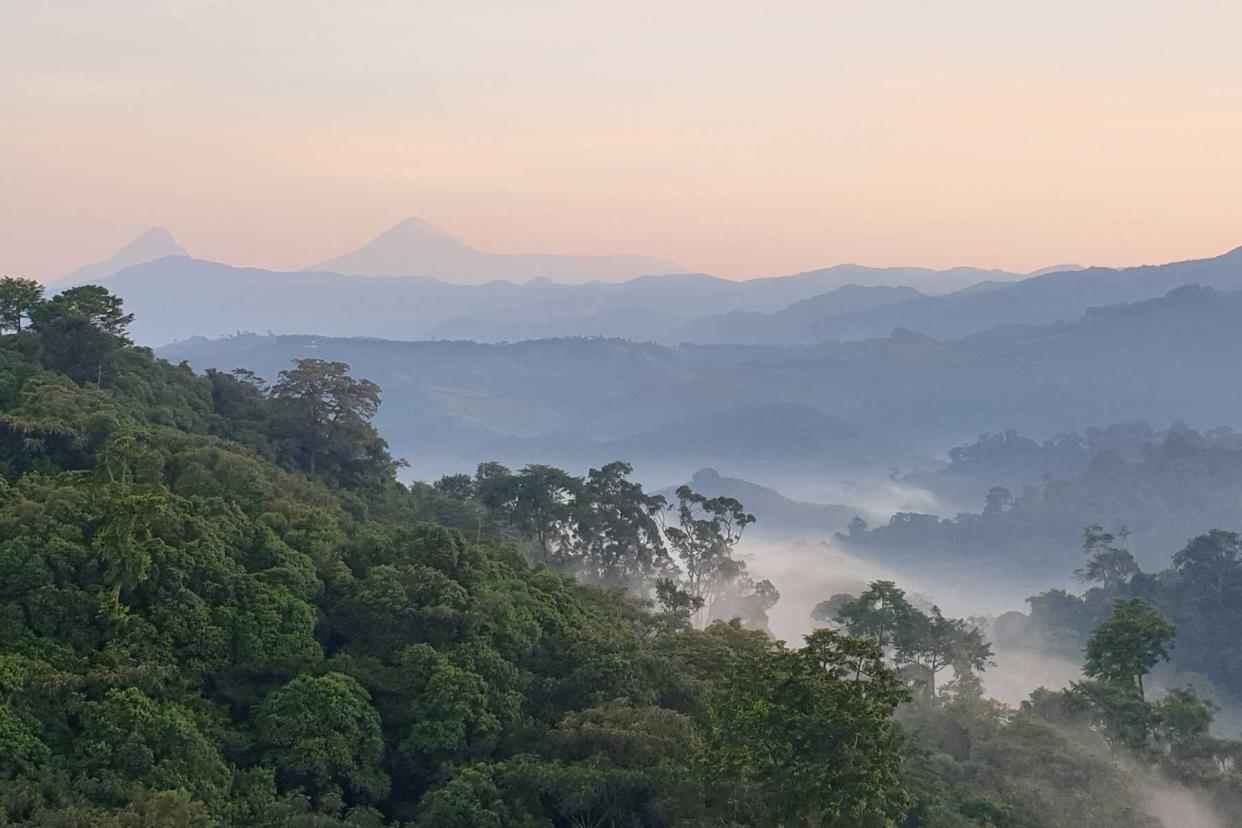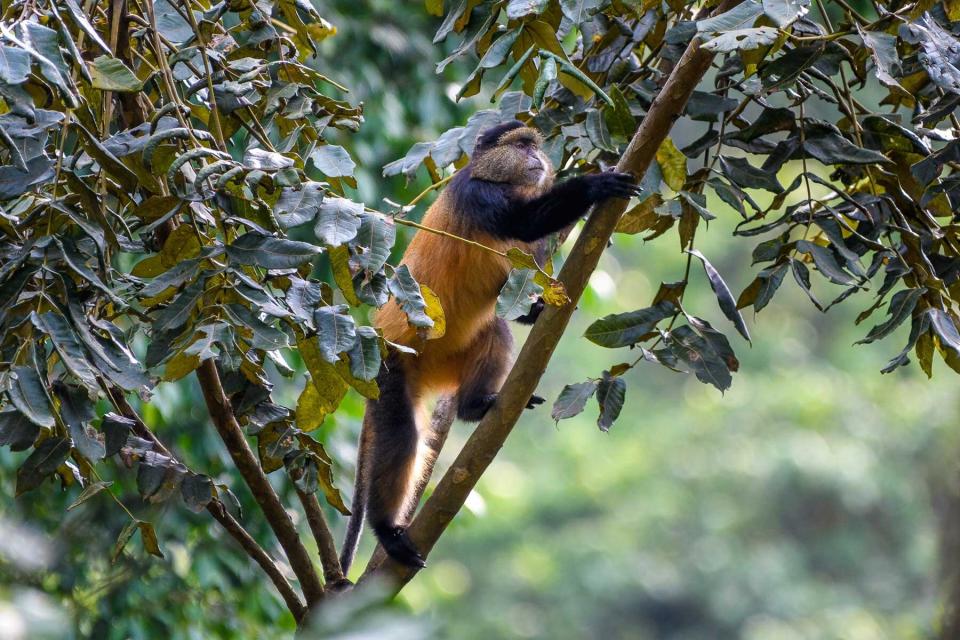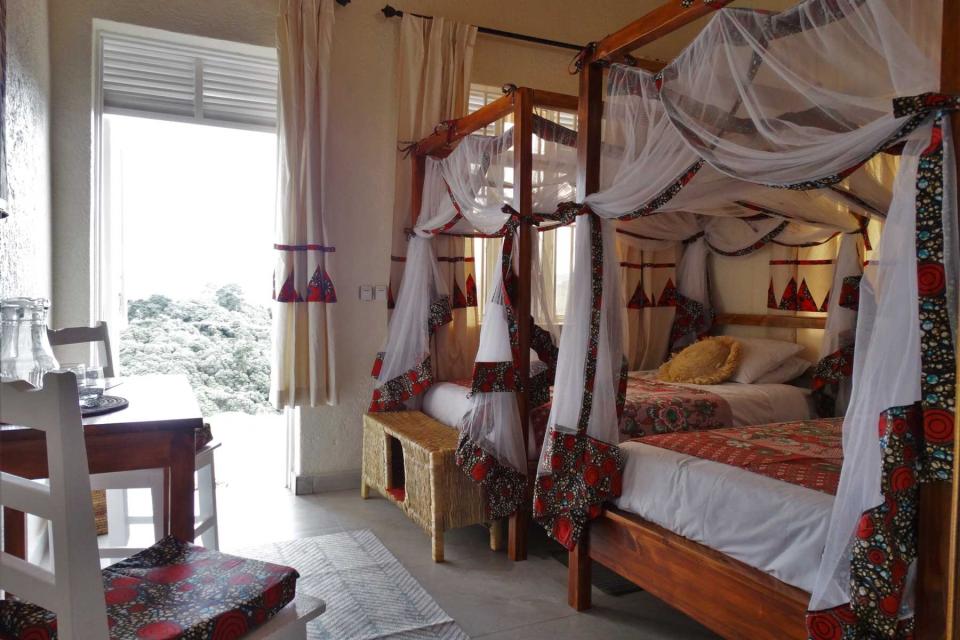Rwanda Has a New Rain Forest Park With Golden Monkeys and Endemic Birds — Here's How to Visit Responsibly

Courtesy of Wilderness Safaris Gishwati Forest is part of Rwanda’s youngest national park.
It is hard to imagine any greater thrill than seeing a primate in its native habitat, living by the rules of the animal kingdom. Even an environmentalist like Thierry Aimable Inzirayineza, who encounters wildlife for his work in Gishwati Forest every day, was beside himself when we spotted a L'Hoest's monkey, with its distinctive white neck ruff, sitting on a mound of earth on the forest floor. The sighting was a small victory for Inzirayineza's Forest of Hope Foundation, which runs the primate-habituation project in Gishwati — the goal of which is to acclimate animals to human visitors. "He is not afraid," Inzirayineza said of the monkey, which would typically have hidden in the forest canopy when humans were nearby. "This is a sign that our efforts are working."
The moment was made even more memorable by the fact that, with the exception of Inzirayineza and a tracker named Innocent Mutangana, my husband, Mark, and I had this jungle — the fluting tropical boubou birds, the droopy red amaranthus blossoms, the crashing waterfalls — entirely to ourselves. Gishwati is the newest park to join Rwanda's rapidly growing ecotourism circuit, and we were some of its first international visitors.
The refuge is located along the Albertine Rift, a ridge that runs almost 1,000 miles from Zambia to Uganda and is one of Africa's most biodiverse regions. The forest once covered more than 250,000 acres; sadly, after decades of poaching and clear-cutting by farmers and cattle ranchers, it was further depleted following the 1994 genocide. In the aftermath of that tragedy, during which more than 800,000 Rwandans were slaughtered, many who had fled to neighboring countries resettled in Gishwati, converting forest into farmland in the process. Twenty years ago, only 1,500 acres remained — less than 1 percent of the forest's original footprint — along with a handful of chimpanzees and L'Hoest's and golden monkeys.

Courtesy of Wilderness Safaris Golden monkeys are one of several primate species in Gishwati.
The tiny patch of surviving jungle drew the attention of Rwandan environmentalists who, with the support of international donors and grants, created Forest of Hope. In 2012, Inzirayineza, a conservation biologist fresh out of college, was hired to generate ideas, and funds, to help restore Gishwati. "I heard the history of this place, and I knew I had to do something to save it," he said. That work involved educating nearby communities about how they could benefit from conservation revenues if they would commit to fencing in their cattle herds and stop poaching animals for bushmeat. He led the push for the government to pledge resources to Gishwati and the nearby Mukura Forest. In 2019 the areas jointly opened as the country's fourth national park, Gishwati-Mukura.
Around the same time, ecotourism pioneer Wilderness Safaris entered the picture. "We had one look and thought, we need to protect this forest," operations manager Ingrid Bass told me. The Rwandan government gave the company a 25-year lease to manage the tourism concession. Today, Gishwati Forest measures nearly 4,000 acres, and the hope is to grow it by another 2,500. The forest is still a fraction of its former size — but, crucially, it is large enough for primate populations to happily roam and breed in.
A decade ago, there were an estimated 10 chimpanzees in Gishwati; today there are 35. The golden monkey population is thriving, too: more than 172 now live there, according to the 2018 census, up from 100 in 2014. L'Hoest's monkeys are flourishing, as are 232 bird species, including 20 that are endemic to the Albertine Rift.
On the four-hour drive to Gishwati from Kigali, the Rwandan capital, our SUV bumped through tidy concrete villages and fields of grazing sheep until we arrived at the two-room Forest of Hope guesthouse. Our quarters were basic but spotless, accented with kitenge-cloth bedspreads and Rwandan mats and baskets. As rain began to stir the forest, I sat on the terrace overlooking the blue-gray Mount Matyazo and sipped bitter Rwandan black tea as a purple-breasted sunbird whistled in the distance.
Wilderness Safaris doesn't own or operate the guesthouse (it plans to construct a larger lodge in the park in the next few years), but it trains Forest of Hope in all areas of hospitality, from the design of the common area, with its mocha leather chairs, to the wonderful meals served on the sunlit patio. For lunch we ate roast chicken and potatoes, homemade bread, vinegary cucumbers, and a lemon posset tart.

Courtesy of Wilderness Safaris A family-size room at the Forest of Hope guesthouse.
Like many forests in Rwanda, Gishwati once consisted largely of eucalyptus trees, imported at the start of the 20th century by German and Belgian missionaries and colonial officials to prevent soil erosion and provide fast-growing timber. Though the trees make the air smell glorious, they bear no fruit for the primates to eat. Today, park workers are clear-cutting eucalyptus for firewood and building materials and replacing them with native myrianthus, ficus, and Dombeya trees, all of which provide food for indigenous wildlife. More than 10,000 have already been planted under Wilderness Safaris' stewardship, with the same number expected to be added over the course of 2022.
In the morning, I set out to do my part in the primate-habituation process. Bass explained that the more humans with different hair and skin colors the animals encounter, the more relaxed they are around us — and our wildlife-seeking cameras. "You are, actually, helping to develop this experience with your very presence," she said.
Chimpanzees are traditionally more elusive (and fewer in number) than golden monkeys in this park, so we set out in search of the latter. After hiking an arduous hour on just-cut trails, Mutangana got word from the bush: the golden monkeys were in sight. Then we saw a large male, about the size of a big dog, fling himself from a giant carapa tree into a cluster of treetops. Another swiped a clutch of bamboo and swung across the forest canopy, his limbs long and powerful. We watched four males zigzag down a branch in single file as if the descent were choreographed, while two bronze-coated females hung side by side in a parasol tree. In all, we witnessed eight members of this group going about what was for them an ordinary day in the jungle. For us, the sight was truly extraordinary.
We continued down toward a distant waterfall. As Inzirayineza led us along the trails he had helped carve out, he reflected on his vision for this unique place that, through his efforts, is returning to life. "Ten years ago, no one would have believed what we see today," he said. "I want a visitor to come and say, simply, 'I am here, alone, in this indigenous forest.'" My experience that morning was every bit as singular — and profound — as he had hoped.
fharwanda.org; Forest of Hope guesthouse from $250 per person, including park permits.
A version of this story first appeared in the August 2022 issue of Travel + Leisure under the headline "New Growth."

